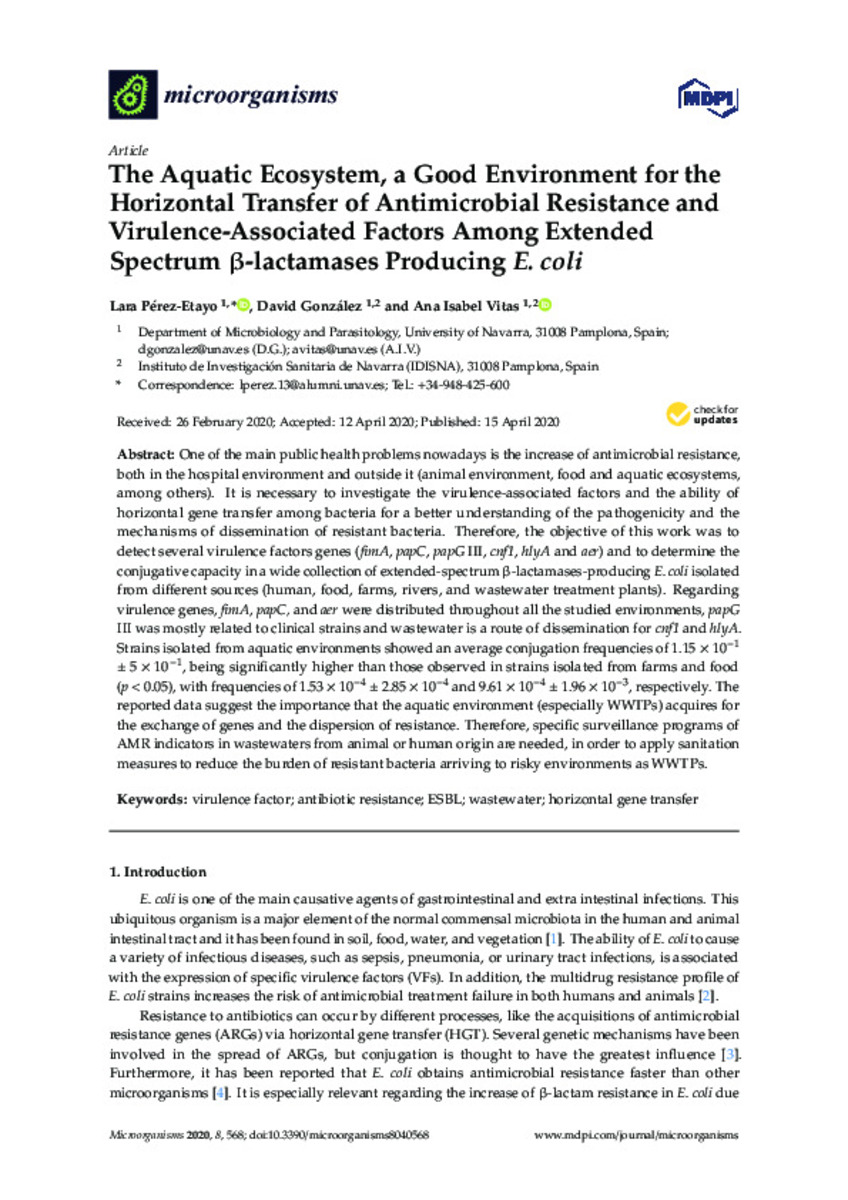Full metadata record
| DC Field | Value | Language |
|---|---|---|
| dc.creator | Pérez-Etayo, L. (Lara) | - |
| dc.creator | González, D. (David) | - |
| dc.creator | Vitas, A.I. (Ana Isabel) | - |
| dc.date.accessioned | 2022-10-06T08:14:28Z | - |
| dc.date.available | 2022-10-06T08:14:28Z | - |
| dc.date.issued | 2018 | - |
| dc.identifier.citation | Pérez-Etayo, L. (Lara); González, D. (David); Vitas, A.I. (Ana Isabel). "The aquatic ecosystem, a good environment for the horizontal transfer of antimicrobial resistance and virulence-associated factors among extended spectrum ß-lactamases producing E. coli". MICROORGANISMS. 8 (4), 2018, 568 | es |
| dc.identifier.issn | 2076-2607 | - |
| dc.identifier.uri | https://hdl.handle.net/10171/64390 | - |
| dc.description.abstract | One of the main public health problems nowadays is the increase of antimicrobial resistance, both in the hospital environment and outside it (animal environment, food and aquatic ecosystems, among others). It is necessary to investigate the virulence-associated factors and the ability of horizontal gene transfer among bacteria for a better understanding of the pathogenicity and the mechanisms of dissemination of resistant bacteria. Therefore, the objective of this work was to detect several virulence factors genes (fimA, papC, papG III, cnf1, hlyA and aer) and to determine the conjugative capacity in a wide collection of extended-spectrum β-lactamases-producing E. coli isolated from different sources (human, food, farms, rivers, and wastewater treatment plants). Regarding virulence genes, fimA, papC, and aer were distributed throughout all the studied environments, papG III was mostly related to clinical strains and wastewater is a route of dissemination for cnf1 and hlyA. Strains isolated from aquatic environments showed an average conjugation frequencies of 1.15 × 10−1 ± 5 × 10−1 , being significantly higher than those observed in strains isolated from farms and food (p < 0.05), with frequencies of 1.53 × 10−4 ± 2.85 × 10−4 and 9.61 × 10−4 ± 1.96 × 10−3 , respectively. The reported data suggest the importance that the aquatic environment (especially WWTPs) acquires for the exchange of genes and the dispersion of resistance. Therefore, specific surveillance programs of AMR indicators in wastewaters from animal or human origin are needed, in order to apply sanitation measures to reduce the burden of resistant bacteria arriving to risky environments as WWTPs. | es_ES |
| dc.description.sponsorship | This research was funded by a grant of “la Caixa” Banking Foundation and the “Asociación de Amigos de la Universidad de Navarra”. | es_ES |
| dc.language.iso | eng | es_ES |
| dc.publisher | MDPI AG | es_ES |
| dc.rights | info:eu-repo/semantics/openAccess | es_ES |
| dc.subject | Virulence factor | es_ES |
| dc.subject | Antibiotic resistance | es_ES |
| dc.subject | ESBL | es_ES |
| dc.subject | Wastewater | es_ES |
| dc.subject | Horizontal gene transfer | es_ES |
| dc.title | The aquatic ecosystem, a good environment for the horizontal transfer of antimicrobial resistance and virulence-associated factors among extended spectrum ß-lactamases producing E. coli | es_ES |
| dc.type | info:eu-repo/semantics/article | es_ES |
| dc.description.note | This article is an open access article distributed under the terms and conditions of the Creative Commons Attribution (CC BY) license (http://creativecommons.org/licenses/by/4.0/). | es_ES |
| dc.identifier.doi | 10.3390/microorganisms8040568 | - |
| dadun.citation.number | 4 | es_ES |
| dadun.citation.publicationName | MICROORGANISMS | es_ES |
| dadun.citation.startingPage | 568 | es_ES |
| dadun.citation.volume | 8 | es_ES |
Files in This Item:
Statistics and impact
Items in Dadun are protected by copyright, with all rights reserved, unless otherwise indicated.






